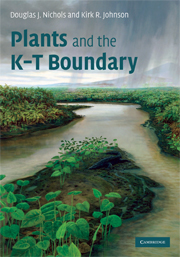12 - Floral effects of the K–T boundary event
Published online by Cambridge University Press: 22 August 2009
Summary
At the scale of western North America, the paleobotanical record appears to document a mass extinction of plant species over the time represented by a centimeter of sediment. Before 1980, temporal resolution of the rock record was coarse and no such statement could have been made with any sense of certainty. The K–T boundary provided a testable hypothesis that is still being examined. Our results seem to suggest that Traverse (1988a) was incorrect in asserting that all changes in floras throughout time have been due to gradual replacement. It now appears that it is possible for plants, like animals, to suffer abrupt mass extinction.
The radiation of the angiosperms that began at the start of the Cretaceous was well under way by the end of the period some 80 million years later and most terrestrial ecosystems either contained or were completely dominated by angiosperms. The K–T extinction, while selective at the environmental scale as evidenced by the apparent preferential survival of mire plants, was not obviously selective at a taxonomic level. That is to say, no major plant groups disappeared at the boundary, and the damage primarily occurred at the species level as local ecosystems independently suffered the after-effects of the impact. Floral recovery from the event seems to have taken the duration of the Paleocene with the awkward exception of the Castle Rock rainforest, whose presence less than two million years after the event remains enigmatic.
- Type
- Chapter
- Information
- Plants and the K-T Boundary , pp. 229 - 230Publisher: Cambridge University PressPrint publication year: 2008

